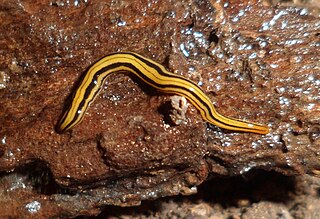
Geoplanidae is a family of flatworms known commonly as land planarians or land flatworms.

Geoplaninae is a subfamily of land planarians endemic to the Neotropical region. Members of this family are sometimes referred to as the Neotropical land planarians. However, one species, Obama nungara has been introduced in Europe.

Luteostriata is a genus of land planarians from Brazil characterized by a yellow body with dark longitudinal stripes.

Obama is a genus of land planarians from South America. It contains several species adapted to human-disturbed environments, including the only invasive land planarian native to the Neotropical realm, Obama nungara, which has been accidentally introduced in Europe.

The reproductive system of planarians is broadly similar among different families, although the associated structures can vary in complexity.

Choeradoplana is a genus of land planarians found in South America.

Paraba is a genus of land planarians from South America.

Cratera is a genus of land planarians found in South America.

Pasipha is a genus of land planarians from South America.

Notogynaphallia is a genus of land planarians from South America.

Issoca is a genus of land planarians from Brazil.
Gigantea is a genus of land planarians from the Neotropical realm.
Liana is a genus of land planarians. It is monotypic, being represented by the single species Liana guasa, which occurs in Chile.
Timyma is a genus of land planarians from Chile. It is the sole genus of the subfamily Timyminae.

Tasmanoplana is a genus of land planarians from Australia.

Pseudogeoplana is a genus of land planarians of the subfamily Geoplaninae. It was erected to include species lacking sufficient morphological information to allow them to be classified in the appropriate genus.

Paraba multicolor is a species of land planarian belonging to the subfamily Geoplaninae. It is found within Brazil.

Geoplanini is a tribe of land planarians in the subfamily Geoplaninae.
Sarcoplanini is a tribe of land planarians in the subfamily Geoplaninae.
Paraba tata is a species of land planarian belonging to the subfamily Geoplaninae. It is found within Brazil.












